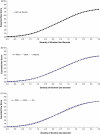Dimensionality of DSM-IV nicotine dependence in a national sample: an item response theory application
- PMID: 20045597
- PMCID: PMC3321925
- DOI: 10.1016/j.drugalcdep.2009.11.012
Dimensionality of DSM-IV nicotine dependence in a national sample: an item response theory application
Abstract
Background: Research focusing on the development of a dimensional representation of DSM-IV nicotine dependence is scarce and prior research has not assessed the role of nicotine use criteria in that a dimensional representation, nor the invariance of the DSM-IV nicotine dependence criteria across important population subgroups.
Methods: Using a large, representative sample of the U.S. population, this study utilized item response theory (IRT) analyses to explore the dimensionality of DSM-IV nicotine dependence criteria and several candidate criteria for cigarette use among past-year cigarette smokers (n=10,163).
Results: Factor analyses demonstrated the unidimensionality of nicotine dependence criteria and IRT analyses demonstrated good fit of the observed responses and the underlying, unobserved latent trait of dependence severity. The model containing all seven DSM-IV dependence criteria, along with the consumption criterion of smoking at least a quarter of a pack of cigarettes in a day in the past year, was identified as the best-fitting model. No differential criterion functioning was shown across sex, race-ethnicity, and age subgroups.
Discussion: Major implications of this study are discussed in terms of the addition of a dimensional representation of nicotine dependence to pre-existing categorical representations of the disorder in the DSM-V, and the need for a nicotine consumption criterion to improve representations of nicotine dependence severity.
Copyright 2009. Published by Elsevier Ireland Ltd.
Figures




Similar articles
-
Dimensionality of hallucinogen and inhalant/solvent abuse and dependence criteria: implications for the Diagnostic and Statistical Manual of Mental Disorders-Fifth Edition.Addict Behav. 2011 Sep;36(9):912-8. doi: 10.1016/j.addbeh.2011.04.006. Epub 2011 May 28. Addict Behav. 2011. PMID: 21621334 Free PMC article.
-
Nicotine dependence, abuse and craving: dimensionality in an Israeli sample.Addiction. 2011 Sep;106(9):1675-86. doi: 10.1111/j.1360-0443.2011.03484.x. Addiction. 2011. PMID: 21545668 Free PMC article.
-
Are social fears and DSM-IV social anxiety disorder associated with smoking and nicotine dependence in adolescents and young adults?Eur Psychiatry. 2000 Feb;15(1):67-74. doi: 10.1016/s0924-9338(00)00209-1. Eur Psychiatry. 2000. PMID: 10713804
-
Toward an alcohol use disorder continuum using item response theory: results from the National Epidemiologic Survey on Alcohol and Related Conditions.Psychol Med. 2006 Jul;36(7):931-41. doi: 10.1017/S003329170600746X. Epub 2006 Mar 27. Psychol Med. 2006. PMID: 16563205
-
The role of psychiatric disorders in the relationship between cigarette smoking and DSM-IV nicotine dependence among young adults.Nicotine Tob Res. 2008 Mar;10(3):439-46. doi: 10.1080/14622200801901898. Nicotine Tob Res. 2008. PMID: 18324562 Free PMC article.
Cited by
-
Childhood neighborhood context and adult substance use problems: the role of socio-economic status at the age of 30 years.Public Health. 2018 Dec;165:58-66. doi: 10.1016/j.puhe.2018.09.011. Epub 2018 Oct 25. Public Health. 2018. PMID: 30384029 Free PMC article.
-
The association of unemployment from age 21 to 33 with substance use disorder symptoms at age 39: The role of childhood neighborhood characteristics.Drug Alcohol Depend. 2017 May 1;174:1-8. doi: 10.1016/j.drugalcdep.2017.01.005. Epub 2017 Feb 20. Drug Alcohol Depend. 2017. PMID: 28273647 Free PMC article.
-
A latent class analysis of DSM-IV and Fagerström (FTND) criteria for nicotine dependence.Nicotine Tob Res. 2011 Oct;13(10):972-81. doi: 10.1093/ntr/ntr105. Epub 2011 Jul 21. Nicotine Tob Res. 2011. PMID: 21778154 Free PMC article.
-
Tobacco Use and 12-Month Suicidality Among Adults in the United States.Nicotine Tob Res. 2017 Jan;19(1):39-48. doi: 10.1093/ntr/ntw136. Epub 2016 May 17. Nicotine Tob Res. 2017. PMID: 27190402 Free PMC article.
-
Dimensionality of hallucinogen and inhalant/solvent abuse and dependence criteria: implications for the Diagnostic and Statistical Manual of Mental Disorders-Fifth Edition.Addict Behav. 2011 Sep;36(9):912-8. doi: 10.1016/j.addbeh.2011.04.006. Epub 2011 May 28. Addict Behav. 2011. PMID: 21621334 Free PMC article.
References
-
- American Psychiatric Association . Diagnostic and Statistical Manual of Mental Disorders. third ed. Rev. American Psychiatric Association; Washington, DC: 1987.
-
- American Psychiatric Association . Diagnostic and Statistical Manual of Mental Disorders. fourth ed. American Psychiatric Association; Washington, DC: 1994.
-
- Bentler PM. Comparative fit indexes in structural models. Psychol. Bull. 1990;107:203–246. - PubMed
-
- Birnbaum A. Some latent trait models. In: Lord FM, Novick MR, editors. Statistical Theory of Mental Test Scores. Addison-Wesley; Reading, MA: 1968. pp. 397–472.
-
- Bock RD, Aitkin M. Marginal maximum likelihood estimation of item parameters: application of an EM algorithm. Psychometrika. 1981;46:443–445.
Publication types
MeSH terms
Grants and funding
LinkOut - more resources
Full Text Sources
Miscellaneous

